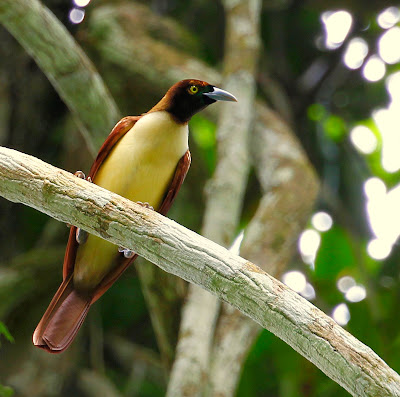 |
| Male Paradisaea Minor |
The Lesser
Bird of paradise, is a bird of paradise belongs to the genus Paradisaea. Paradisaea Minor is a scientific name of Lesser bird of paradise,
Paradisaea is a Latin word which means paradise, and minor is also a Latin word
which means lesser, its common name differentiaties its smaller size with the
similar but larger Greater Bird of Paradise. The Lesser Bird of paradise is an average sized, up to
32 cm in length (excluding central tail wires), dark brown with a yellow
crown and brownish yellow from upperside. The adult male has a dark emerald green
throat, a pair of long tail wires and is delightful with decorative flank
plumes which are deep yellow at their bottom and decolorize outwards into
white. The adult female has a dark brown head with and yellow back of the neck and covering, dark brown
upperparts and white underparts. It shows up probably that birds of paradise
also own toxins in their skins,
reproduced from their insect prey. |
| Mating Rituals Paradisaea Minor |
Behaviour:
The adult males
are polygamous,
and adult males participate traditional tree perches in lekking
system. Up to 12 adult males may display in
single lek tree, often with several female plumaged young males in attendance.
Sovereign and older males keep hold of centre of Lek and make show of most
copulations. Males shortly hold wings and throw flank plumes over back then jumps up and back along
perch raising or lowering beak on each trip. The
adult females normally lay two pinkish eggs with
dark markings in a nesting a tree high above ground. Their
diet consists mostly of fruits and
insects.
 |
| Female Paradisaea Minor |
Breeding & Habitat:
Lesser
bird breeding duration is at
least July to February. Adult females build and attend nests alone, possibly
lay up to 12 eggs. Their nests are massive open like cups, built in tree
branches. The
Lesser Bird of paradise is spread out throughout forests of northern New
Guinea, and the closest islands of Misool and Yapen, Vogelkop and north of mainland eastward as far as mouth of Gogol River,
upper Ramu River, and along the north west coast of Peninsula. Lesser bird also
found lowland and hill forest, forest edges and nonessential growth, change to
environments modified by humans (0 to 1550 meters). Widespread and collective all
along its large range, the Lesser Bird is estimated as Least Concern on the IUCN
Red List of
Threatened Species. It is listed on Appendix II of CITES.
No comments:
Post a Comment